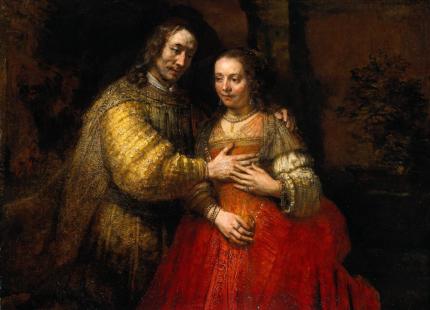-
Par MMaxi le 16 November 2007 à 05:24

Title Prometheus Being Chained by Vulcan, Year 1623
On the floor in a smithy lies Prometheus.
The gods' smith, Vulcan, is fastening handcuffs on him.
Filled with pity, the messenger of the gods, Mercury watches this happening.
Van Baburen has presented this story from Greek mythology in all its
dramatic power and significance.
Prometheus, his face creased in anguish, churns the air with his arms.
The treatment of light and the life size figures reflect the influence
of the Italian painter Caravaggio.
-
Par MMaxi le 30 October 2007 à 19:07

Artist Rembrandt Harmensz. van Rijn Year 1633
Rembrandt painted this portrait of Saskia Uylenburgh in 1633. She was twenty years old at the time and had just become engaged to Rembrandt. They were married a year later. Saskia was the niece of the art dealer Hendrick Uylenburgh, in whose house Rembrandt lived in Amsterdam. Rembrandt had moved to Amsterdam in 1631 where he remained for the rest of his life. From the moment he arrived he received many commissions for portraits, producing more than fifty in the first year alone.
-
Par MMaxi le 14 October 2007 à 22:15

Paula Rego
The Family 1988
In The Family the absent father and husband returns to the picture plane, only to be manhandled by his daughter and his wife. As usual, the narrative clues are ambiguous, and the story could have several endings. Are the women helping the man or hurting him? Who is the little girl at the window? Do the clues perhaps lie in the Portuguese retablo featuring St. Joan, and St George slaying the dragon? Or in the fable of the stork and the fox illustrated beneath? Is the man as doomed as the dragon, or will he in fact resurface like the fox, to eat the stork, once it has removed the bone lodged in his throat?
-
Par MMaxi le 14 October 2007 à 01:05

The story at the heart of the painting came to Paula Rego ready-made in the form of Jean Genet's play The Maids (1947), itself based on the real-life case of the Papin sisters, Christine and Lea, who worked as maids for a rich Parisian family. One day, frightened for no apparent reason other than that of a power cut which inconvenienced and possibly frightened the sisters, they brutally murdered the mother and daughter of the family while the man of the house was out at work. In working with the story, Paula Rego seems to have focused on the unnatural closeness of the sisters, both to each other and the mother and daughter they murder. Ambiguity and menacing psychosis reverberate within the picture, much of it carried in the objects with which the room is claustrophobically furnished. And isn't there something uncertain about the sexuality of the seated figure?
Paula Rego's Biography and Exhibitions
BIOGRAPHY
1934 Born in Lisbon
1945-51
Educated in St Julian's School, Carcavelos
1952-56 The Slade School of Art, London
1956-63 Lived in Ericeira, Portugal, with her husband, the painter Victor Willing, and three children
1962-63 Bursary from the Gulbenkian Foundation, Lisbon
1976 Settled permanently in London
1983 Visiting Lecturer in Painting Slade School of Art
1990 Appointed the First National Gallery Associate Artist
1992 Honorary Master of Art, Winchester School of Art, 12 June
1999Honorary Doctorate of Letters, University of St. Andrews, Scotland, 24 June
Honorary Doctorate of Letters, University of East Anglia, Norwich, 8 July
2000 Honorary Doctorate of Letters, Rhode Island School of Design, USA, 3 June
2002 Honorary Doctorate of Letters, The London Institute, 23 May
2004Grã Cruz da Ordem de Sant'Iago da Espada presented by the President of Portugal
2005Commissioned by the Royal Mail to produce a set of Jane Eyre Stamps
Honorary Doctorate of Letters, Oxford University, June
Honorary Doctorate of Letters, Roehampton University, July
Currently lives and works in London
-
Par MMaxi le 4 October 2007 à 01:00

An elegantly dressed man and woman are in a vague, dark room. The man has lovingly placed his arm around the woman's shoulder and a hand on her breast. Very carefully she touches his hand with her fingertips. Both are staring straight ahead, they seem deep in thought. A few objects can be recognised in the obscure background: beside the woman is a plant in a pot and behind her an architectural fragment. The picture, called the 'Jewish Bride', was painted by Rembrandt in 1667. It is one of the most famous and mysterious paintings in the museum's collection.
Jewish bride?
The painting became known as the 'Jewish Bride' in the early nineteenth century after the Amsterdam art collector, Van der Hoop, identified the subject of the painting as a Jewish father hanging a necklace around his daughter's neck on her wedding day.
Today, no one sees this man has the woman's father anymore. It is clearly a couple, although who they are is not clear. The faces appear to be portraits, but the clothes are unusual for the time. Perhaps they were contemporaries of Rembrandt's who posed as characters from the Bible.
-
Par MMaxi le 2 October 2007 à 14:26

Title
Interior of an Inn with an Old Man, the Landlady and Two Men Playing Backgammon, known as 'Two Kind
Year
c. 1636-79
A group of men are having fun in a tavern. A young man is drinking beer, draining his tankard, while a couple of others are playing backgammon. Like cards, this popular game was associated with idleness and folly. On the left, another game is being played: an old man tries to pull a young woman (the landlady) onto his lap. The woman resists him half-heartedly. Her red stockings, however, suggest that she would not have been all that worried about her morals: red stockings often indicated the woman was a prostitute. Taverns were sometimes disguised brothels and this place certainly has a rather dubious air. The lute on the wall, the dog, the pipe on the firepan and the mussel and eggshells on the ground suggest debauchery, lust and idleness.
Jan Havicksz. Steen (1626-1679)
Jan Havicksz. Steen was born in Leiden in 1626, the son of a brewer. Educated at a Latin school he enrolled in 1646 at Leiden university, although he was never to actually graduate. Little is known for certain about Steen's apprenticeship as a painter. Early eighteenth-century biographers of artists record that he was taught by various painters: Nicolaus Knupfer, Adriaen van Ostade as well as landscape painter Jan van Goyen, whose daughter he married in 1649. One year earlier he had registered as a master painter with the Leiden guild of artists, indicating that his apprenticeship was now over.
-
Par MMaxi le 22 August 2007 à 23:20

Gilbert, b. 1943, Dolomites, Italy
George, b. 1942, Devon, England
Gilbert was born Gilbert Proesch in 1943 in the Italian Dolomites. He studied at the Wolkenstein School of Art and Hallein School of Art, Austria and the Akademie der Kunst, Munich. George was born George Passmore in 1942 in Devon, England. He was schooled at the Dartington Adult Education Centre, Devon; Dartington Hall College of Art; and the Oxford School of Art. Gilbert and George met while students at the St. Martin’s School of Art, London in 1967, and have lived and worked together in London since 1968.
Moving to the working-class neighborhood of Spitalfields in London, Gilbert and George revolted against art’s elitism, naming their house “Art for All” and declaring themselves “living sculptures.” Although their early work centered around Performance, the artists soon turned to video, photography, and drawing. As early as 1969, the artists were given an exhibition at the Stedelijk Museum, Amsterdam, and by 1972–73 were frequently showing with prestigious galleries like Anthony d’Offay Gallery, London, Sonnabend Gallery, New York, and Galerie Konrad Fischer, Düsseldorf. Their use of black-and-white photographic assemblages first surfaced in 1971 and by the late 1970s had developed into gridlike photo combinations. The duo was invited to participate in Documenta in Kassel in 1972, 1977, and 1982. In 1980, the Stedelijk Van Abbemuseum, Eindhoven, organized a mid-career retrospective of the artists’ work, which traveled to the Kunsthalle Düsseldorf, Kunsthalle Bern, Centre Georges Pompidou, Paris, and Whitechapel Art Gallery, London.
In the first years of the 1980s, Gilbert and George added a range of bright colors to their photographs, emphasizing their slick, stylized, and cartoonlike appearance. The content of the work of this period centered around urban life and the hope and fear associated with modern society. In 1986, Gilbert and George were awarded the Turner Prize, and in 1987 had a major exhibition at the Hayward Gallery, London. In 1989, Gilbert and George exhibited 25 large pieces dealing with illness and destruction at Anthony d’Offay Gallery for an AIDS charity organization. The following year, the artists created The Cosmological Pictures, which toured ten different European museums from 1991 to 1993. Gilbert and George also exhibited in Moscow in 1990. In 1992, their largest production ever, New Democratic Pictures, was exhibited at Aarhus Kunstmuseum, Aarhus, Denmark. This was followed by a solo exhibition at the National Art Gallery, Beijing, and the Art Museum, Shanghai, in 1993. In 1994, the artists were given an exhibition at the Museo d’Arte Moderna, Lugano, Switzerland. Gilbert and George live in London.
-
Par MMaxi le 16 May 2007 à 23:38

TITEL: Miss January 1997
Biography:
1953Born in Cape Town, South Africa
1972-1975
BA Fine Art, University of Cape Town
1976-1978
Atelier 63, Haarlem, Netherlands
1979-1980
Institute of Psychology, University of Amsterdam
Artist's Writings Marlene Dumas
I never meant to stay
l suppose that's what they all say.
It was my first time in a peepshow
so when the girl smiled at me
I said, 'Only looking', and she replied,
That's how I got started here too'.
Art and Prostitution
lf a Prostitute is a person
who makes it a profession
to gratify the lust of various persons
for economical reasons or gain,
where emotional involvement may
or may not be present-
Then it seems not so far removed
from my definition of an artist.
Artists usually love to pretend.
Artists usually pretend to Iove
much more than they can handle.
They want everyone to want them
while they don't want anybody.
Fame and Fortune
You can't get away from
the people you don't like
because they pay for you.
Sweet Nothings, op. cit., pp. 114, 131. 'Art and Prostitution' was originally published in the catalogue Auf
dem Strich: Arbeiten zum Thema Prostitution, Kulturviertel im Sophieenhof, Kiel, Germany. 'Fame and
Fortune' is previously unpublished
MMaxi
-
Par MMaxi le 15 April 2007 à 13:46

Bearded Man with Loincloth, ca. 1909 Albertina, Vienna.
Schiele's 1909-10 postcard designs anticipate several of his later allegorical concerns, such as the concept of the artist
as a holy figure.
Child with Halo in a Field of Flowers, ca. 1909, Albertina, Vienna
The " Holy Child, " Symbolizing the creative spirit, reappears in the later paintings
" Birth of Genius " and " Dead Mother "
-
Par MMaxi le 15 April 2007 à 13:36

Two Men With Halos, ca. 1909, Albertina, Vienna.
In late 1909 or early 1910, Schiele proposed a series of four postcard designs to the Wiener Werkstatte.
Although many young artists, including Kokoschka, earned extra money doing projects such as this, the Werkstatte rejected
Schiele's proposal.
It has been suggested that Schiele intended to depict himself and Klimt in the present design.
Two intertwined Male figures, ca. 1909, Albertina, Vienna.
 Follow this section's article RSS flux
Follow this section's article RSS flux
MMaxi Madeiraman




